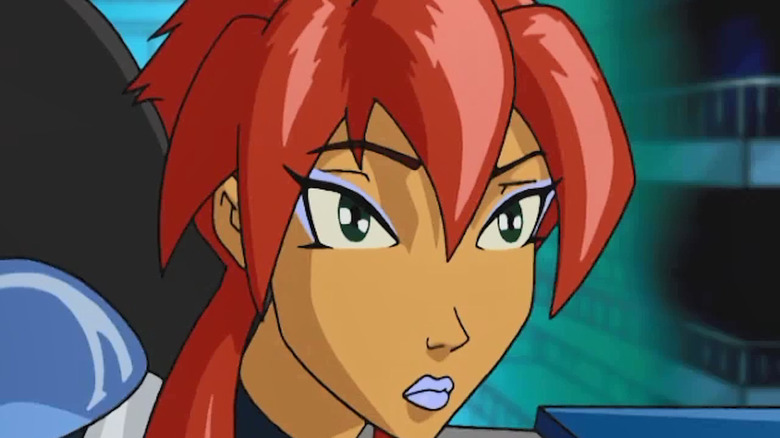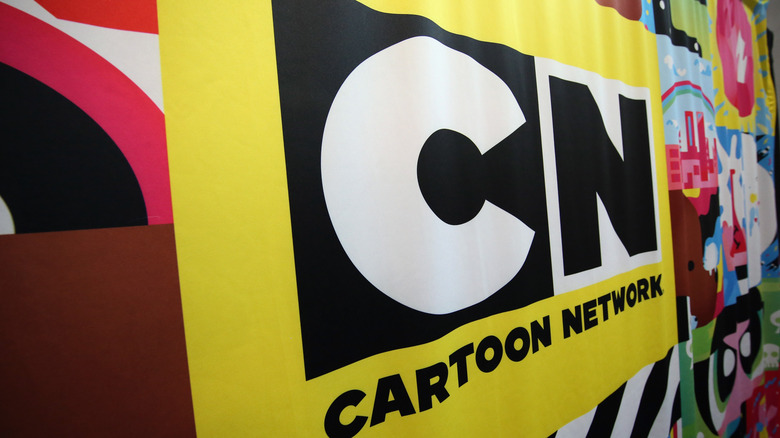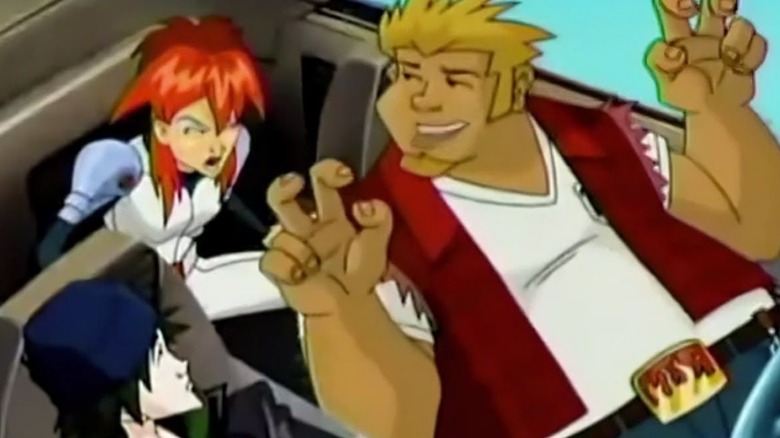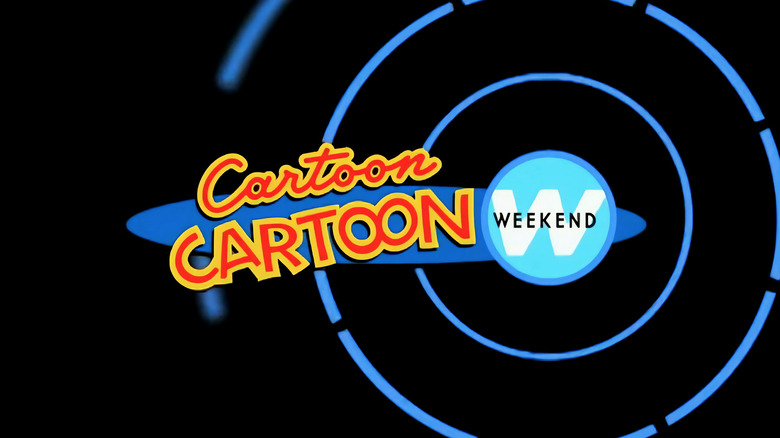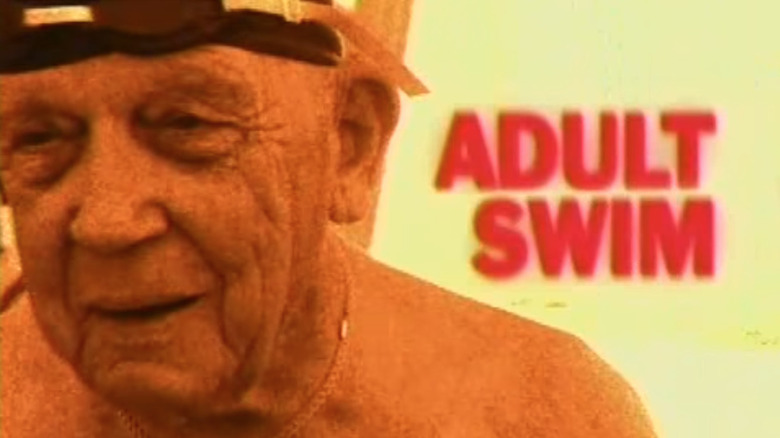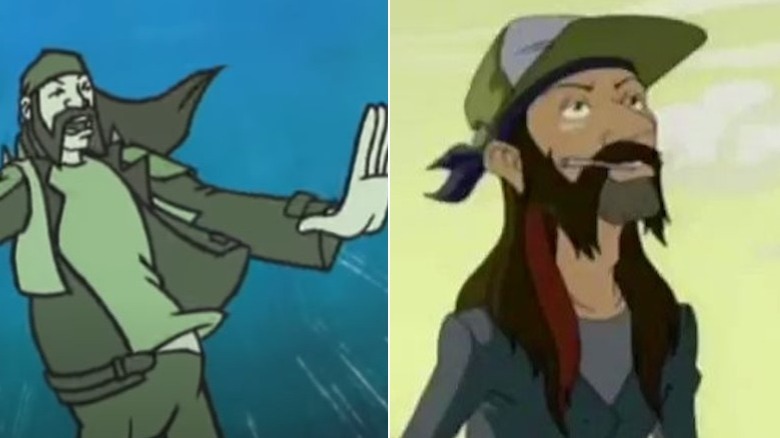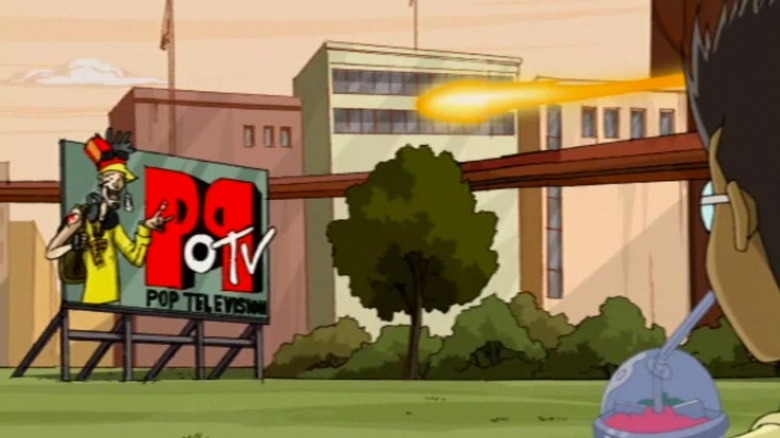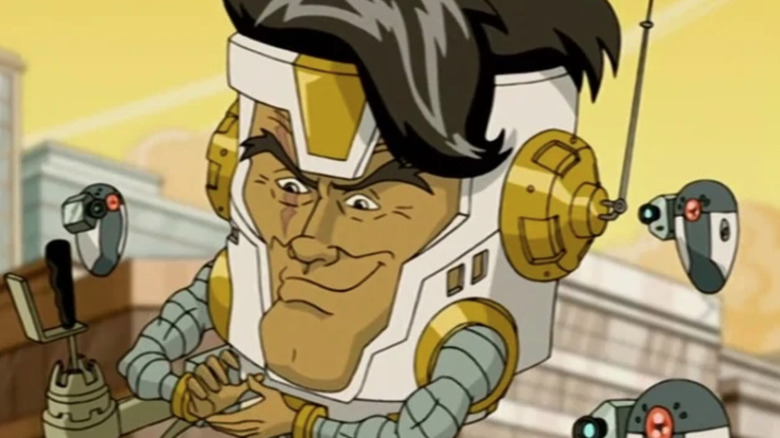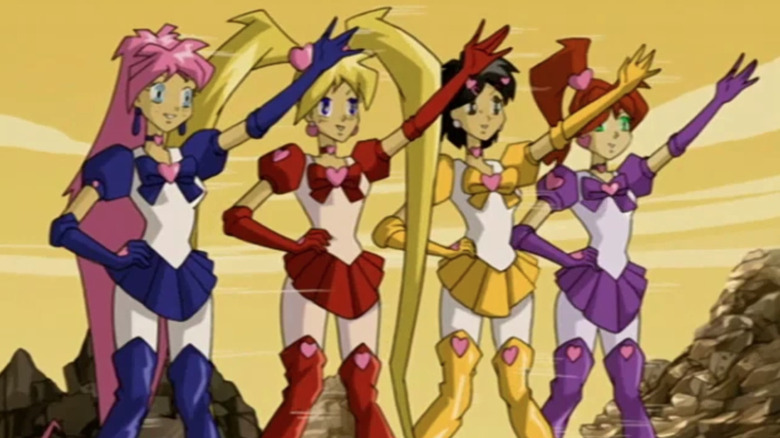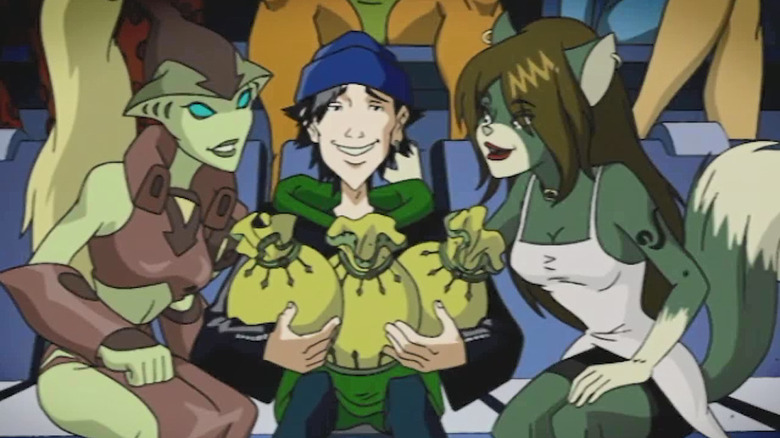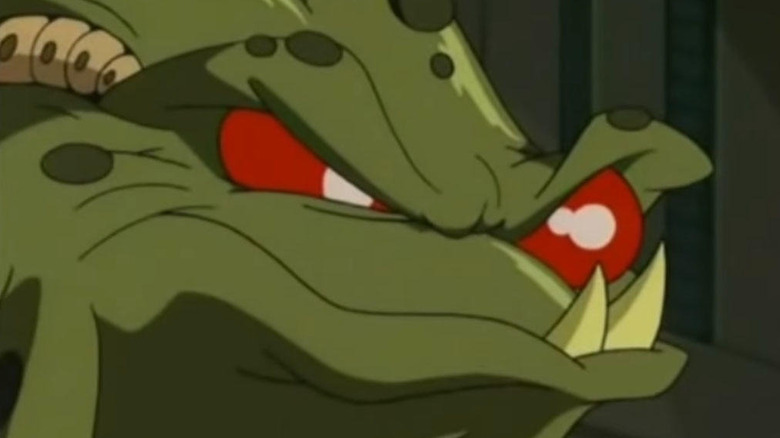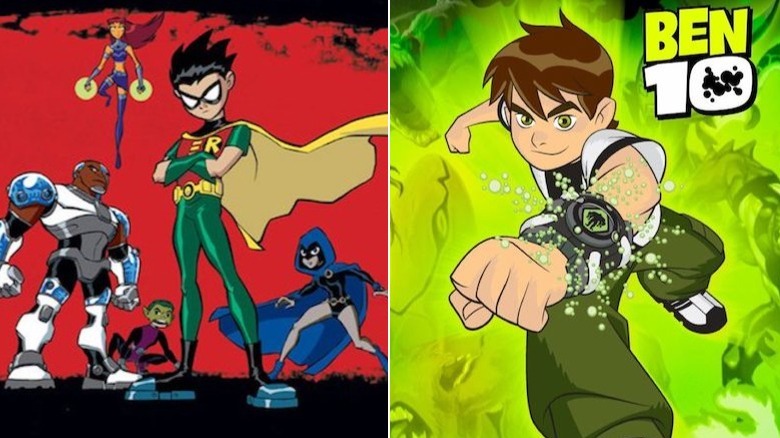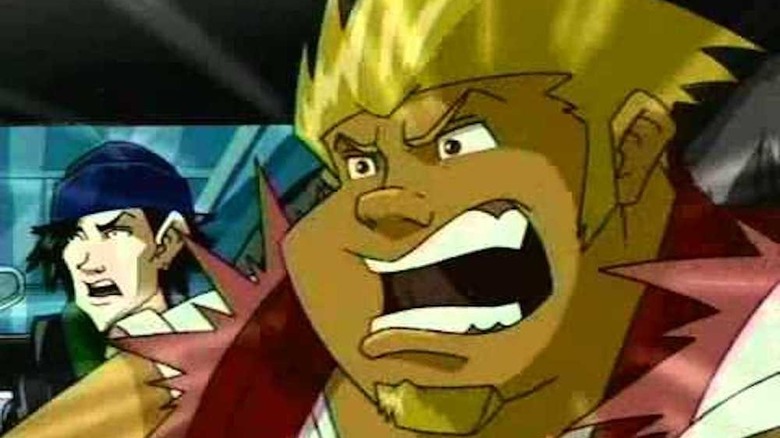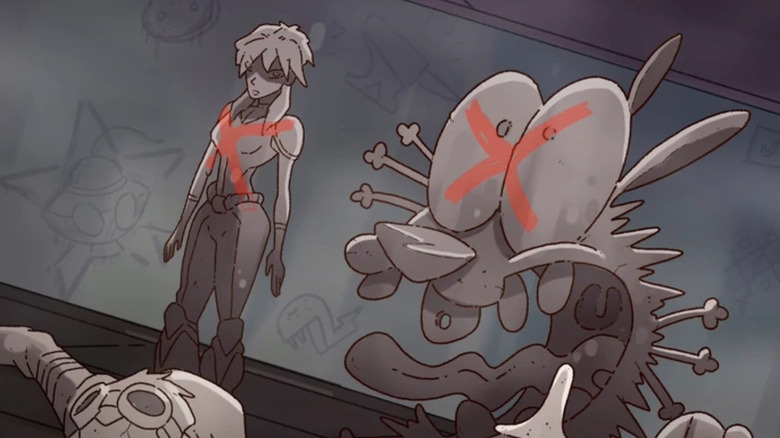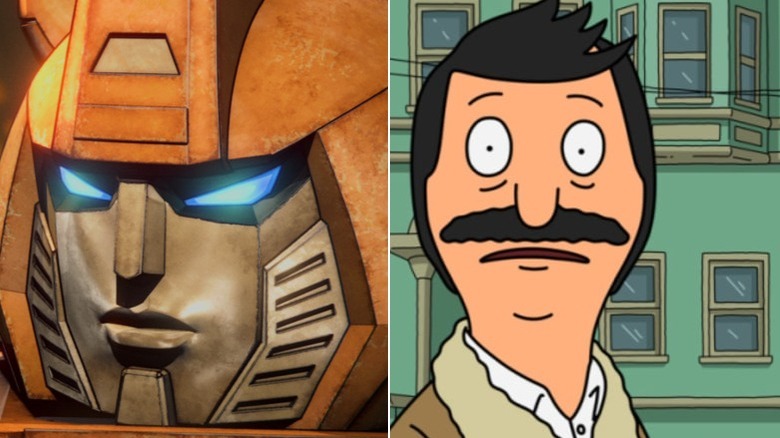The Untold Truth Of MEGAS XLR
"I dig giant robots! You dig giant robots! We dig giant robots! Chicks dig giant robots!" So goes the theme song to the 2004-2005 animated action-comedy "MEGAS XLR," one of Cartoon Network's most underrated original series. Created by George Krstic and Jody Schaeffer, this Toonami series put a parodic spin on the conventions of mecha anime. Instead of an angsty teenager piloting a giant robot to save humanity from alien invaders, an oafish slacker from New Jersey named Coop finds an advanced mecha from the future and customizes it into a cool car he just wants to use for fun. At the urging of time-traveling warrior Kiva, Coop and his even more useless friend Jamie do end up saving the world, but not without extensive collateral damage.
Running for two 13-episode seasons and quickly disappearing from Cartoon Network's schedule after that, "MEGAS XLR" has fallen into obscurity with the general public, but has maintained a passionate cult following — one that would love nothing more than to see a proper continuation or reboot. The story of how this show got made and why it is, in many ways, just as surprising and absurd as the cartoon itself.
It was pitched via VHS at Comic Con
If you're an aspiring cartoon creator looking to pitch a series to Cartoon Network, "MEGAS XLR" serves as an example of how not to do a pitch. Rather than the traditional routes of going through an agent, working their way up through other productions, or responding to an open call for pitches, creators George Krstic and Jody Schaeffer instead put together a rough pilot short on a VHS tape and gave it directly to Cartoon Network executive Linda Simensky at Comic Con International in San Diego.
The one thing keeping this unorthodox pitching method from being an inappropriate ambush was that Schaeffer and Simensky already knew each other because she was one of his professors at the School of Visual Arts. "Granted, she knew me as 'that guy that always fell asleep in her class,' but in my defense I was working full time and commuting to school five days a week," Schaeffer told Comic Art Community. "She's also very understanding."
Anime studio Madhouse animated the pilot
When Cartoon Network accepted the pitch for "MEGAS XLR," the network gave Krstic and Schaeffer the chance to develop a more professionally polished pilot short. Titled "LowBrow: Test Drive," this pilot short had slightly different designs from the series proper, but was a mostly-formed introduction to the plot, characters, and sense of humor. Many of the jokes and even large sections of the short's animation were fully recycled for the first full-length episode of "MEGAS XLR."
Befitting the heavy anime influence on the story and art style, the "LowBrow" pilot was actually animated by the legendary Japanese anime studio Madhouse. Madhouse's credits include such popular series as "Trigun" and "Death Note" as well as movies like "Millennium Actress" and "Summer Wars." Madhouse would not return to animate the rest of the series, which instead was handled in South Korea by Sunwoo Entertainment and Digital eMation.
It won the Cartoon Cartoon Weekend Summerfest
"LowBrow: Test Drive" premiered on August 23, 2002 as part of the Cartoon Cartoon Weekend Summerfest, alongside eight other short animated pilots. The Cartoon Cartoon Weekend Summerfest followed two consecutive years of Cartoon Network holding "Big Pick" competitions where audiences would vote on their favorite pilots to be made into series. "The Grim Adventures of Billy and Mandy" won the Big Pick in 2000, with the runner-up "Whatever Happened to... Robot Jones?" also receiving a series, and "Codename: Kids Next Door" won in 2001.
Unlike the two Big Pick events, the Cartoon Cartoon Weekend Summerfest didn't air with promises of turning the most popular pilot into a series, but viewers still got the chance to vote for favorites — and "LowBrow" was a clear favorite, the only pilot from the event to receive a series green light. At the "MEGAS XLR" Reunion Panel at Toon Con 2019, Schaeffer claimed, "They didn't want us to win, but we blew everybody else out of the water." The pilot would rerun in 2003 as part of Toonami's Giant Robot Week.
Production began too early to go to Adult Swim
A commonly-held opinion about "MEGAS XLR" was that it would have been a better fit for Adult Swim than for all-ages Cartoon Network. With its adult slacker antiheroes and extensive parodies of retro pop culture, its sensibility definitely skewed older than most of Cartoon Network's programming, even without getting particularly risqué. If "MEGAS XLR" had entered development even a year later, there's a good chance it would have been an adult show.
In an interview with The Waffle Press, Jody Schaeffer said, "Adult Swim came out, like, a year or two after we had been in production ... and if it had been an entity when we were pitching it, that's almost certainly where we would have gone." Adult Swim launched in late 2001 with a line-up compromised of extremely low-budget shows and acquisitions; "The Venture Bros.," the block's first higher-budget original, was greenlit in 2002, the same year the "LowBrow" pilot aired, and eventually premiered in 2004, the same year as the full "MEGAS XLR" series.
Goat is a real person (and in multiple shows)
In Season 1 of "MEGAS XLR," Scot Rienecker is credited as the voice actor for Goat, the lazy womanizing junkyard operator. In Season 2, the voice credit changed to "Goat as himself." This is neither a change in actors nor is it just a joke credit: Scot Rienecker goes by the nickname "Goat" and is the basis for the character in "MEGAS XLR."
A college friend of Krstic, Schaeffer, and director/producer Chris Prynoski, Rienecker has been turned into multiple different cartoon characters whom he's voiced himself. Before "MEGAS XLR," Goat was a character in Chris Prynoski's MTV series "Downtown." He switched from a cigarette to a lollypop when making the jump from MTV to Cartoon Network. The character of Jacob in Prynoski's 2012 Disney XD series "Motorcity" is also voiced by Rienecker and bears a striking resemblance to the two previous "Goat" characters.
Working out anger at MTV
If "MEGAS XLR" seemed short-lived with only 26 episodes, that's still double what "Downtown" received on MTV. Chris Prynoski's 1999 grunge New York sitcom was cult favorite and even received an Emmy nomination for Outstanding Animated Program, but love and critical acclaim didn't stop it from being canceled after one season. Prynoski had reason to be upset with MTV, as did George Krstic and Jody Schaeffer, who served respectively as a writer and a director for "Downtown."
This anger led to one of the pettiest yet funniest running gags in "MEGAS XLR." Nearly every episode features the destruction of something (a satellite, a billboard, a building, etc.) emblazoned with the logo for the music television station "PoP TV." With the two "P"s bright red and the second "P" backwards, it's obvious whose logo this is supposed to resemble. (Keep in mind this was a decade before the actual "Pop TV" station came into being.) Krstic takes pride in this running gag, telling Untied Magazine, "We were still sore about the way MTV treated 'Downtown' at the end, so that was my way of getting back at them. Petty? Sure. Satisfying? Very."
Begging Bruce Campbell to voice act
"Battle Royale," the third episode of "MEGAS XLR," introduced the comical villain Magnanimous, a M.O.D.O.K.-esque giant floating head who runs (and rigs) the Galactic Combat Federation — and is voiced by none other than "Evil Dead" star Bruce Campbell. Magnanimous returned in the Season 2 episode "The Return," in which he challenges Coop to defend his championship title.
The story of how this relatively small Cartoon Network show got its most famous celebrity guest star was recounted by George Krstic and Chris Prynoski at the Toon Con 2019 "MEGAS XLR" Reunion Panel. Campbell's management rejected their official requests, but Prynoski went to a screening of "Bubba Ho-Tep" where Campbell was doing a Q&A and personally begged the actor to appear in his cartoon. Campbell was allegedly confused but interested enough that he gave Prynoski his agent's number, which ultimately led to him making his guest appearances as Magnanimous.
Season 2 was never officially greenlit
From pitching to casting, it's clear the "MEGAS XLR" crew didn't do things the traditional way, but George Krstic has said that the weirdest part of the production was getting a second season (via Twitter). The story of this second season pickup was discussed during the Toonami Faithful Podcast episode celebrating the show's 10th anniversary (starting around an hour and 19 minutes in). Technically, "MEGAS XLR" didn't even have an official Season 2 pickup at all!
It's explained that because of how long animation takes to produce, scripts have to be written way in advance. A few episodes into the production of "MEGAS XLR" Season 1, the crew had the go-ahead to start writing scripts for a potential Season 2. They accidentally interpreted this as a go-ahead to start doing storyboard and design work for Season 2, and eventually enough time and money had been spent on this "unofficial" work that the executives didn't actually bothering stopping them.
Unmade merchandise plans
With the popularity of "Transformers" action figures and "Gundam" model kits, "MEGAS XLR" should theoretically have been a very easy cartoon to merchandise. Cartoon Network never actually licensed any "MEGAS XLR" toys, aside from some Jollibee toys internationally and a single expensive limited edition collectible statue released via DC Direct. But this was not for lack of trying on the part of the show's crew.
The team went so far as to make their own toys (remodeled from a Gundam and other preexisting figurines) and filmed a fake advertisement, which was shown at a Cartoon Network staff meeting and later released on the DVD set of "Downtown." Toys weren't the only merchandise to be demanded but never actually released. There are multiple forum posts referencing an Adult Swim bumper which claimed a DVD release of "MEGAS XLR" Season 1 was scheduled for release in Fall 2005. This DVD set never actually came out.
Season 3 would have revealed the Glorft's origins
If "MEGAS XLR" had managed to get a third season, what sort of things would have happened in it? Crew members have shared various tidbits of potential Season 3 ideas over the years via podcasts, conventions, and social media. One of the most notable of these tidbits, discussed during the 2019 Toon Con reunion panel, involves the origin story of the Glorft, the evil alien force the MEGAS was supposed to fight in the future.
It was a recurring bit throughout the series that Coop often caused more damage out of sheer carelessness than the show's villains caused out of malice. A proposed Season 3 gag would have taken it to the next level. In one episode, Coop was going to sneeze in a toxic waste dump, causing a chain of rapid evolution resulting in the first Glorft appearing. Coop was already an antihero, but this would have made him (accidentally) almost singularly responsible for the entire intergalactic war in the first place.
Teen Titans and Ben 10 led to its cancelation
Given the brevity of its two-season run, it would be natural to assume "MEGAS XLR" did poorly in the Nielsen ratings, but this was not the case. Kristic wrote on his blog that "we were actually breaking records — until they started moving us around." So why would Cartoon Network want to cancel a popular action show? One factor was a decision to focus its energy on two other action shows targeted at the same tween boy audience: The 2003 "Teen Titans" and the original "Ben 10" (which premiered in 2006, a year after "MEGAS XLR" ended, but was in development at the studio at the same time).
"[Although] our ratings were doing on par with theirs," Schaeffer told Comic Art Community, "CN felt that they didn't need three in-house shows that went after the same basic demographic. We also skewed a little older, and that wasn't a good thing back then." It probably didn't help matters that Simensky, the executive responsible for greenlighting "MEGAS XLR," left Cartoon Network in 2003 to move to PBS.
A tax write-off stopped a reboot
In the years since "MEGAS XLR" was canceled, the show's fanbase has remained passionate. In 2012, the hashtag #BringBackMEGASXLR started trending, and Prynoski, Krstic, and Schaeffer to began to look into the possibility of some sort of revival of their gone-too-soon cartoon. There were talks of a reboot or video game adaptation, but hopes of these plans coming to fruition were quashed by the fact Cartoon Network used the original series as a tax write-off.
Krstic explained in a 2014 interview with Untied Magazine, "'Megas' was written off as a tax loss and as such can not be exploited, at least domestically, in any way, or the network will get into some sort of tax/legal trouble." This is why the series never received a DVD release, though somehow it was made available for purchase on iTunes and the XBox Store. Schaeffer offered a more hopeful perspective on the matter in a 2019 interview with The Waffle Press: "We've talked about that. You can't never say never ... 'MEGAS' still airs in South America and other markets and it is still making them money ... [at this point] it's probably pretty close to at least breaking even, which, when that happens, who knows what the future holds."
Cameo in OK K.O.! Cartoon Network crossover
Despite the tax write-off, Cartoon Network hasn't completely ignored "MEGAS XLR" in the years since its cancelation. In 2012, Coop was visible in some of the network's 20th birthday promotions. Later, in 2018, Kiva appeared as one of multiple classic Cartoon Network characters turned to stone in the "OK K.O.! Let's Be Heroes" episode "Crossover Nexus."
"Crossover Nexus" centered around a team-up between K.O. and three of Cartoon Network's then-current heroes (Ben 10, Raven from "Teen Titans Go!" and Garnet from "Steven Universe"), but this episode was packed with fan service for fans of practically every Cartoon Network show. Beyond just "MEGAS XLR," characters from shows as "The Moxy Show," "Sheep in the Big City," and "Hi Hi Puffy AmiYumi" cameoed. "OK K.O.!" creator Ian Jones-Quartey revealed on Twitter artists had to find the original model sheets for all of these cameos to make them as accurate as possible.
The creators work on Transformers and Bob's Burgers
Creators George Krstic and Jody Schaeffer have gone on to have long careers since the cancelation of "MEGAS XLR." They collaborated once again on Chris Prynoski's "Motorcity," which has been described as a spiritual successor to "MEGAS XLR," but have mostly worked on separate projects. Krstic was a writer on the first season of "Star Wars: The Clone Wars" and contributed material to the video game "League of Legends." He returned to the world of giant robots, developing two "Transformers" series: The webseries "Transformers: Combined Wars" and the Netflix epic "Transformers: War for Cybertron Trilogy."
While Krstic is primarily a screenwriter, Schaeffer works primarily on the art and storyboarding side of the animation industry. After "MEGAS XLR" concluded in 2005, he went to Prynoski's studio Titmouse, where he worked on such series as "Metalocalypse," "Moonbeam City," and "Big Mouth" — and provided the voice for the iconic "chirp" in the studio's logo. In 2019, he moved from Titmouse to Bento Box, where he's storyboarded on such sitcoms as "Hoops," "The Great North," and "Bob's Burgers."
